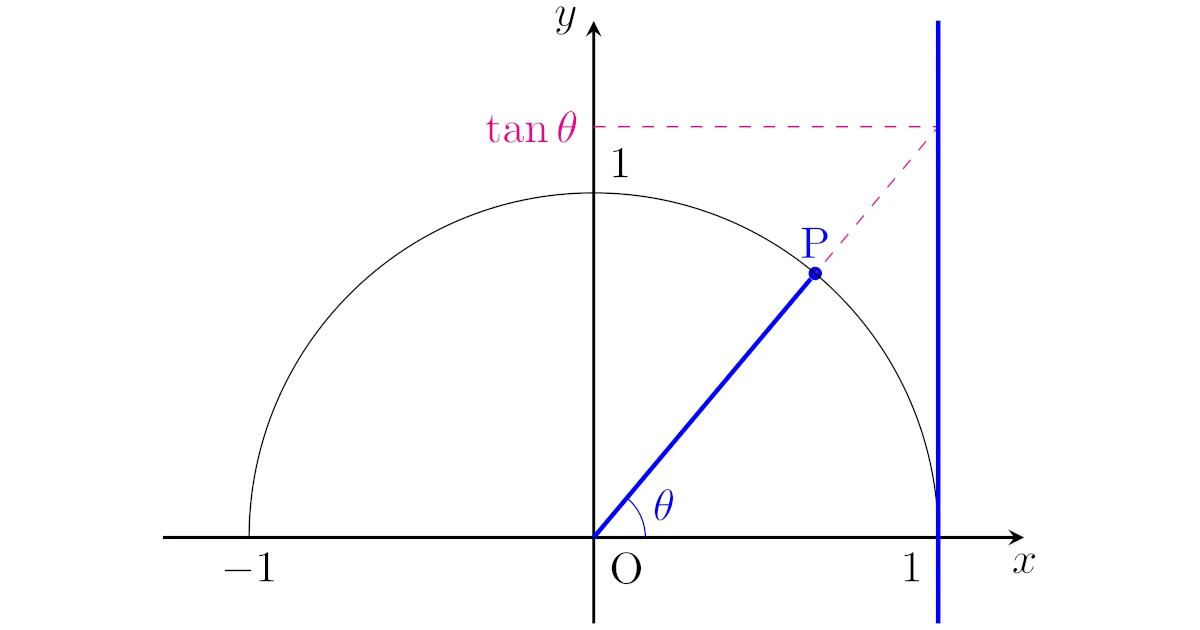直角三角形のひとつの鋭角を$\theta$として三角比$\sin{\theta}$, $\cos{\theta}$, $\tan{\theta}$を考えると,三角形の内角の和は$180^\circ$なので$\theta$は$0^\circ<\theta<90^\circ$の範囲でしか考えることができません.
そこで$\theta$の範囲をさらに拡張して三角比$\sin{\theta}$, $\cos{\theta}$, $\tan{\theta}$を定義しようというのが今回の記事の目標です.
「そんなこと考えて何になんの?」と思うかもしれませんが,鈍角三角形では内角が$90^\circ$以上になることもあるので,$\theta\geqq90^\circ$の場合に$\sin{\theta}$, $\cos{\theta}$, $\tan{\theta}$が定義されていると便利なのです.
この記事では
- 三角比$\sin{\theta}$, $\cos{\theta}$, $\tan{\theta}$の拡張
- 拡張された三角比$\sin{\theta}$, $\cos{\theta}$, $\tan{\theta}$の性質
を順に説明します.
「三角比」の一連の記事
三角比$\sin{\theta}$, $\cos{\theta}$, $\tan{\theta}$の拡張
これまで学んできた直角三角形で定義される三角比$\sin{\theta}$, $\cos{\theta}$, $\tan{\theta}$の基本を確認して,$\theta$を$90^\circ$以上の場合に拡張しましょう.
三角比の基本図形
斜辺の長さが$1$の直角三角形のひとつの鋭角を$\theta$とするとき,斜辺でない2辺の長さが$\sin{\theta}$, $\cos{\theta}$と表せることは当たり前にしておきましょう.
$\mrm{AC}=1$, $\ang{B}=90^\circ$の直角三角形$\tri{ABC}$を考える.このとき,$\theta=\ang{A}$とすると,
が成り立つ.
三角比の定義より
であり,いま$\mrm{AC}=1$だから
が成り立つ.
一般的な呼称ではありませんが,私はこの図を三角比の基本図形と呼んでいます.三角比の定義から
と三角比$\sin$, $\cos$, $\tan$の関係式がすぐに得られますし,三平方の定理から
と三角比$\sin$, $\cos$の関係式もすぐに得られますね.
また,図形を$r$倍に拡大すれば,斜辺が$r$の直角三角形の残りの2辺の長さが$r\sin{\theta}$, $r\cos{\theta}$と表せることもすぐに分かりますね.
三角比$\sin{\theta}$, $\cos{\theta}$, $\tan{\theta}$(${0^{\circ}\leqq\theta\leqq180^\circ}$)の定義
上で考えた三角比の基本図形を$xy$平面上に頂点$\mrm{A}$が原点,線分$\mrm{AB}$が$x$軸上,点$\mrm{C}$の$y$座標が正となるように下図のようにおきましょう.
このとき,点$\mrm{C}$の$x$座標は$\cos{\theta}$で,$y$座標が$\sin{\theta}$となりますね.
この図をふまえて$\sin{\theta}$, $\cos{\theta}$, $\tan{\theta}$を$0^\circ\leqq\theta\leqq180^\circ$で定義しましょう.
原点$\mrm{O}$の$xy$平面において,$y$座標が$0$以上の単位円上の点$\mrm{P}$,点$\mrm{A}(1,0)$を考える.$\theta=\ang{AOP}$とするとき,
- $\mrm{P}$の$x$座標を$\cos{\theta}$
- $\mrm{P}$の$y$座標を$\sin{\theta}$
と定める.また,$\cos{\theta}\neq0$のとき,$\tan{\theta}=\dfrac{\sin{\theta}}{\cos{\theta}}$と定める.
直角三角形を用いて定義した三角比では,$\tan{\theta}$も辺の比で定義して関係式$\tan{\theta}=\dfrac{\sin{\theta}}{\cos{\theta}}$を導きましたが,ここではこの式によって$\tan{\theta}$を定義しています.
このように定義すれば$0^\circ<\theta<90^\circ$のときは直角三角形で定義した三角比と矛盾せず,$0^{\circ}\leqq\theta\leqq180^\circ$の範囲にまで$\sin{\theta}$, $\cos{\theta}$, $\tan{\theta}$が定義できるわけですね.
ただし,$\tan{\theta}$は$\cos{\theta}\neq0$のときに定義されるということに注意してください.
というのは,数学では0除算(0で割ること)はダメでしたから,$\tan{\theta}=\dfrac{\sin{\theta}}{\cos{\theta}}$の分母は0であってはいけません.
そのため,$\tan{\theta}$は$\cos{\theta}\neq0$となる$\theta\neq90^\circ$の場合を除外して定義するわけですね.
三角比$\sin$, $\cos$, $\tan$の相互関係
先ほども少し触れましたが,$0^\circ<\theta<90^\circ$の場合に三角比の関係式
- $\tan{\theta}=\dfrac{\sin{\theta}}{\cos{\theta}}$
- $\cos^{2}{\theta}+\sin^{2}{\theta}=1$
- $1+\tan^{2}{\theta}=\dfrac{1}{\cos^{2}{\theta}}$
- $1+\dfrac{1}{\tan^{2}{\theta}}=\dfrac{1}{\sin^{2}{\theta}}$
が成り立つのでした.これらの等式は$0^\circ\leqq\theta\leqq180^\circ$の場合でも成り立ちます.
$0^\circ\leqq\theta\leqq180^\circ$を満たす実数$\theta$について,等式
- $\tan{\theta}=\dfrac{\sin{\theta}}{\cos{\theta}}$
- $\cos^{2}{\theta}+\sin^{2}{\theta}=1$
- $1+\tan^{2}{\theta}=\dfrac{1}{\cos^{2}{\theta}}$
- $1+\dfrac{1}{\tan^{2}{\theta}}=\dfrac{1}{\sin^{2}{\theta}}$
が成り立つ.ただし,(1)と(3)は$\cos{\theta}\neq0$のときに,(4)は$\sin{\theta}\neq0$かつ$\tan{\theta}\neq0$のときに成り立つ.
$0^\circ<\theta<90^\circ$のときは$\sin{\theta},\cos{\theta},\tan{\theta}$はいつでも正なので分母が$0$になるかどうかは気にしなくても問題ありませんでした.
しかし,$0^\circ\leqq\theta\leqq180^\circ$の場合には$\sin{\theta},\cos{\theta},\tan{\theta}$が$0$になることがあるので,3つ目と4つ目の関係式は分母が$0$にならないときのみ考えられますね.
$\tan{\theta}=\dfrac{\sin{\theta}}{\cos{\theta}}$は$\tan{\theta}$の定義そのものである.
また,単位円周上の点$(\cos{\theta},\sin{\theta})$と原点$(0,0)$との距離は$1$だから,
が成り立つ.
$\cos{\theta}\neq0$のとき,$\cos^{2}{\theta}+\sin^{2}{\theta}=1$の両辺を$\cos^{2}{\theta}$で割れば,
$\sin{\theta}\neq0$かつ$\cos{\theta}\neq0$のとき,$\cos^{2}{\theta}+\sin^{2}{\theta}=1$の両辺を$\sin^{2}{\theta}$で割れば,
が得られる.

コメント